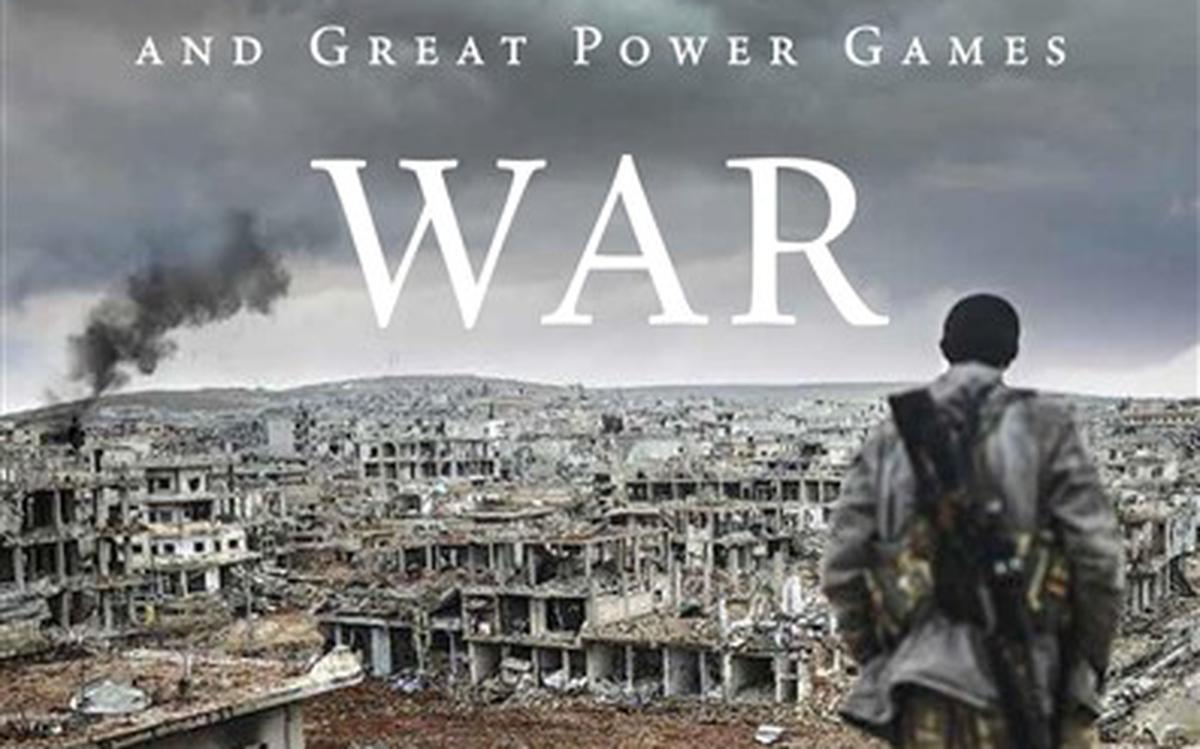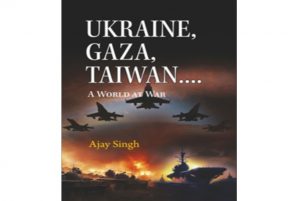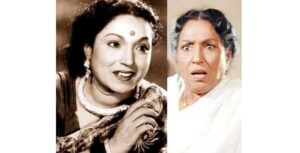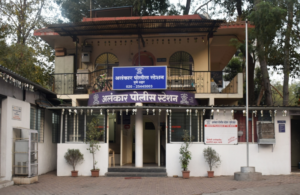WEST ASIA AT WAR: A MONUMENTAL WORK OF RARE SCHOLARSHIP

MAJ GEN JAGATBIR SINGH, VSM (RETD)
Ambassador Talmiz Ahmed in a book of rare scholarship has written what might arguably be rated as amongst the best books on West Asia from an Indian perspective. His canvas is wide both geographically and historically which ranges from the Napoleonic invasion of Egypt to events of the present but what stands out is his deep understanding of the region and his analysis including India’s relations with the region. His book is also a combination of a practitioner having served in this region and an academic.
The enormity of events in West Asia and North Africa since the beginning of the twentieth century and the historical background of those events is clearly explained. The author has explained all the links wherever required and has the ability to connect the dots in a lucid manner and this helps the reader comprehend the inherent complexities.
Beginning with Napoleon’s attack on Egypt in 1798, Ambassador Ahmad traced the impact of Europe on West Asia. He then covers the five decades of upheaval beginning in 1900 which is the colonial period, and the rise of Arab nationalism from 1950 including the consequences of the establishment of Israel as an independent state, to 1979; a year which can rightly be considered as a watershed with ‘nationalism’ being replaced by ‘religion’ due to the effect of the Iranian revolution of 1979 and other events of that fateful year. The Post-Cold War period, America’s Afghan and Iraq wars and the Arab Spring. But what is of great relevance in India’s engagement with this region?
The Arabs, struggling to rid themselves of centuries of Ottoman dominance, found their sense of superiority shaken by their encounter with Western civilization and were in a predicament. Initially impressed with the ideas and technology, they felt they must learn from them. In 1826, Rif’a al-Tawhati was sent to France by the Khedive of Egypt with a diverse team on a five-year mission that resulted in translating the French Constitution into Arabic. While noting that although it was “the West’s superiority in science and technology” in the last 200 years; though built on ‘Islamic scientific achievements’ was fundamental to their easy domination of Arabia, it was basically the right to “justice and equality” of all citizens, including equality of opportunity, that determined why “their countries had prospered, their knowledge increased, their wealth accumulated and hearts satisfied”.
An equal and opposite reaction sparked the Al-Nahda (‘Renaissance’) that sought to find these same values of liberty, justice and equality, including gender equality, in Islamic tradition. Led by Jamaluddin al-Afghani and his pupil, Muhammad Abduh, this influential school of thought urged ‘reinterpretation of Islam for modern times’. They talked about maslaha (public welfare); shura (consultation); ijtihad (independent reasoning) and ijma (consensus); to “become part of the modern world without abandoning Islam.” Their principal concern was not domestic reform but the battle against imperialism. Therefore, political evolution in the region consists of extremist vs moderate, secular vs theocratic approaches.
Western duplicity continues to dominate Arab politics. The Hashemites whose Bedouin irregulars under Sharif Hussain were instrumental in defeating the Ottoman Turks in the First World War were assured of an “Arab Khaliphate” replacing the Ottoman Caliphate. However; the Arabs were divided by supporting Abdulaziz al-Saud, to the throne of Saudi, while handing over the thrones of Iraq and Transjordan to the sons of Sharif Hussain. Simultaneously, the Jewish settlement in Palestine leads to “regular and increasingly bloody communal riots”. The League mandates might have made French and British occupation of Asian Arabia legitimate in international law, but colonial exploitation remained.
This resulted in protests, an immediate consequence was the emergence of pan-Arab nationalism against the division of Arab lands by the colonial authorities into five separate regions. Arab intellectuals such as Rashid Rida and the distinguished Christian Arab historian George Antonius, in the 1920s and ’30s, and Sati al-Husri, “the most influential Arab thinker through the 1950s and 1960s”, ‘shaped the region’s national aspirations’ into a pan-Arab ideology that incorporated under one umbrella of all the religious faiths of the Arab world. Such Arab nationalism, “was entirely secular. Based on this thinking the Ba’ath (Rebirth) party was founded by two Syrian political activists, Michel Aflaq and Salah al Bitar.
This “Rebirth” resulted in overthrowing a series of Arab monarchies created and sustained by Western intervention: Egypt, Syria and Iraq in the 1950s and, the overthrow of the Shah of Iran by Mosaddeq in 1951, however, once he nationalized oil, the CIA then overthrew him in 1953 replacing him with the Shah. This sowed the seeds for the Iranian revolution by Ayatollah Khomeini in 1979. The republicans in Tunisia obtained freedom from French control in 1956, while Libya overthrew its monarchy in 1969.
The focus of Arab nationalism shifted to Israel after the November 1947 UN partition of Palestine. War broke out almost immediately, but the Arab armies were no match for the Western-funded and equipped Israeli army. Since then, some Arab states have changed their stance on relations with Israel, especially after the military defeats of 1967 and 1973, and more recently at the behest of the United States.
In our context, Mahatma Gandhi and Jawaharlal Nehru were of the view that “Palestine is an Arab country and Arab interest must prevail there…It is the misfortune of the Jews that they have aligned themselves with British imperialism”. They ‘saw the Zionist movement as one directly influenced by British and American interests’. India did not recognise Israel till 1950.
That changed in the 1990s with Prime Minister PV Narasimha Rao extending full diplomatic recognition to Israel, and initiating a process that has resulted in a policy of “balance” towards rival groups in the region; idealism versus a transactional relationship with all.
Islamic sectarianism came to the fore with renewed vigour, following the Iranian revolution, which lead to the Saudi-Iranian rivalry or the clash within Islam between the ‘Shias’ and ‘Sunnis’. This continues to affect every aspect of West Asian politics and various terrorist groups are aligned to these two sects such as Hezbollah and ISIS respectively. What Ambassador Ahmed does is explain the different strands of political Islam.
The Wahhabi doctrine, mainly associated with Saudi Arabia, is where the ruler is accepted as head of the political authority, welfare and guarantor of security, doctrinal support being provided by state-appointed ulema. Contrasted to Wahhabis are Salafis who advocate activism to achieve a state based on Islamic principles. The Muslim Brotherhood, founded by al Banna in 1928 believes ’jihad is an obligation to every Muslim’, and defined Islamic principles with the Koran as the basis of constitutions; governments must function with shura or consultation; a ruler must comply with the laws of Islam and the people’s will.
During the Arab Spring, it was clear that the existing balance between subservience in return for subsidies was overshadowed by economic realities comprising unemployment, food prices, poverty, inequality and lack of freedom. The key was whether the army would support the ruling establishment. When it did not, leaders of Tunisia, Egypt, Yemen and Libya were toppled. In a second wave, the leaders of Sudan and Algeria were deposed. But no monarchy fell and Bahrain’s Emir was saved by Saudi intervention. Counter revolutions to confront political Islam, in particular the Muslim Brotherhood, were staged in Tunisia and Sudan by Saudi Arabia, Egypt and the UAE.
Gulf rulers now depend on making Islam an adjunct of state order and seek legitimacy through appeals to Muslim moderation, Arabic identity and nationalism, with special emphasis on the youth. But the foundation for popular discontentment endures; while there is no Arab state that has popular participation ‘there is no indication of who or what will be the catalyst for change’.
The American presence in the region expanded as the importance of oil increased; its objectives were ‘to ensure the free flow of oil’ and ‘guarantee security of Israel’, and this role has military connotations. Incidentally. The first oil was struck in 1908 in Masjid- i- Sulaiman in Iran, at a site of an ancient ‘fire temple’. It was also important to prevent Soviet influence. As per the book, the greatest influence on US policy is the Israeli lobby, Christian evangelists and neo-conservatives, who neither have vision, realistic goals, nor understanding of Arab resentments about Palestine. The main frictions in the Arab Peninsula are Israel against Palestinians and Saudi Arabia against Iran.
The chapter on India-West Asia ties is an excellent exposition of the changing contours of the relationship. It also factors in Indian-Israeli and Indo-Iranian ties. Indian ‘relations with Saudi Arabia, UAE and Israel occupy the highest place while ties with Iran have been dictated by US sanctions’. Indians are the largest expatriate community in every Gulf country, remit $35 bn each year and total trade with the Gulf reached $121 bn in 2018-19 and the bulk of our oil and natural gas imports come from here. What he does not cover however is the military aspects of our engagement where our troops have played a major role in peacekeeping efforts under the UN umbrella and had also established a military training team in Iraq.
The final Chapter talks about the future of this influential region based on analysis of the recent developments, the socio – economic and political issues including the failure of efforts towards democracy, the US engagement in the region and the changing geopolitical landscape.
Chronological details of crucial events and the impact of ‘Arab-Spring’ on the region with country wise elaboration of facts and analyses gives clarity to the picture. It also gives a perspective of how the fate of one country still remains tied with the others.
From the period when Western invasion began into Egypt and the Arab and adjacent lands in Iran and Turkey, right up to the 21st century, the vastness of the book with its focus on key historical, political, religious and economic developments is indeed most comprehensive. What stands out is the manner in which diverse matters have been weaved into a ‘coherent narrative’ to give an interpretation of the dynamics of the region.
The book tells us that neither the republican nor monarchical models have produced strong Arab states capable of ensuring their own security. They have remained dependent on the US and the rulers dispense patronage from oil money to tribal chiefs and clergy. These revenues enable the rulers to control their citizens through access to education and health, silencing any demand for reform, and threaten them with the heavy hand of repression at the first sign of dissent.
It is a deeply engaging book which gives details of every significant and crucial event of the region and allied historical aspects that have shaped West Asia. Talmiz Ahmad has an intimate knowledge of West Asia; this imprint is clearly discernible in the book. It is no doubt a monumental work, and provides a great insight of the developments over the past two centuries in a region with which India has had deep historical ties and one which continues to remain vital to our contemporary interests.








